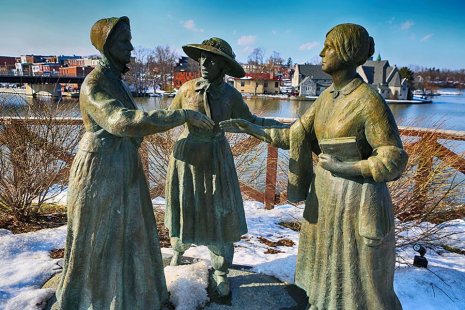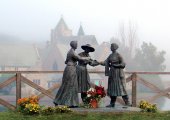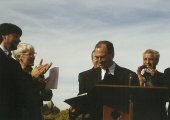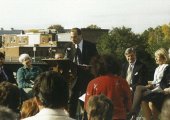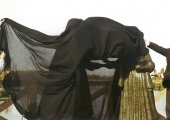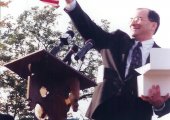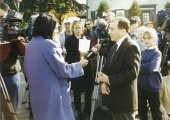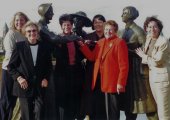“When Anthony Met Stanton” Dedication remarks by A. E. Ted Aub, October 15,1999
Thank you Lieutenant Governor Donahue, Senator Nozzolio, Mayor Jones, Ms. Lynn Rollins, Ms. Jan Caracillo, and all the planners and participants in this program and the other weekend events.
This simple drama depicts an unplanned encounter that took place here–148 years ago. Who could imagine on that spring day in 1851 when Amelia Jencks Bloomer introduced her visiting friend, the young Susan B. Anthony, to Elisabeth Cady Stanton, that this polite social exchange would set the stage for a social revolution. And it all started on these streets, in this village!
It is fitting that we commemorate the moment of their meeting because the powerful alliance that was forged here is one of the remarkable stories of our time.
It is an honor and privilege, yet also a daunting responsibility, to be in the position of interpreter of history. One of the challenges of creating a sculpture like this is to fix in time a particular narrative moment, which involves paring down to an essence that which is most important.
What you see before you is my invention, not a literal reenactment. As a matter of historic and artistic interpretation, my sculpture is a synthesis of many ideas. If I were to list the conceptual components that inspired me, the following would be foremost: gentility, elegance, dignity, strength, confidence, passion and compassion, stubbornness, independence, courage, balance and equality, community, solidarity, beauty, movement, and action.
Given to me as the premise of the commission was the “moment of introduction.” The historical record knows a few facts of the occasion, mostly because Stanton wrote about meeting Anthony for the first time in her autobiography:
How well I remember the day! (She wrote) George Thompson and William Lloyd Garrison having announced an anti-slavery meeting in Seneca Falls, Miss Anthony came to attend it. These Gentlemen were my guests. Walking home, after the adjournment, we met Mrs. Bloomer and Miss Anthony on the corner of the street, waiting to greet us. There she stood,
With her good earnest face and genial smile, dressed in gray delaine, hat and all the same color, relieved with pale blue ribbons, the perfection of neatness and sobriety. I liked her thoroughly. . .
So we know who was there, and something about the style of clothing worn, but more importantly we sense the great affection Stanton felt toward Anthony from the start. From other accounts, we know that both Bloomer and Stanton were wearing the bloomer costume. Certain facts could be researched or gleaned from the archives such as their various bodily statistics (weight, height, ages, etc.) and this was all respected. Photographs exist but only tell a superficial story and there are only a few from the early days. The great abundance of correspondence between the two is perhaps the richest resource.
I tried to create a sculpture that reflects the humility of these three modest but refined women. The human proportion of the sculpture is intended as an invitation for passersby to join their widening circle. Circularity is a theme itself throughout the sculpture and appears in various forms – the shape of Bloomer’s hat, the ovular base, the linear flow of the arms suggesting a figure eight; symbol of continuity.
Each figure is in the process of moving and they are physically moving toward the center with Bloomer as the active catalyst that bridges the two main players. She speaks (!), a symbol of women’s voice, as she makes the introduction. The
Idea of movement was key for its metaphorical value and the formal visual
Dynamic that it creates.
There are some other symbolic objects and concepts in the work: the book Stanton is holding represents her keen intellect. She is without hat and wears a loosely draped shawl. These can be understood as subtle non-conformities consistent with her rebellious character. Her bare arms and hands refer to a rolling-up-of-the-sleeve mentality and are indicative of her direct and enduring leadership in partnership with Anthony.
Anthony moves briskly and proudly, which is suggestive of her role in the campaign as the high profile and public face of the Women’s Movement. Her left hand holds the glove taken off of her right outstretched hand. Their imminent connection is to be flesh to flesh with all the warmth that human contact can have. I felt this was important, though perhaps, unlikely in a proper greeting of the day. The physical touch is preceded by a steady visual gaze between the two, foreseeing a relationship that would last more than fifty years.
The central hands are the focal point of the sculpture. Capturing the instant “before” places the viewer in the presence of the essential moment. As a visual device, it creates tension and anticipation where past, present, and future are all rolled into one. It lends energy to the work because it forces us to play out the scenario in our mind’s eye. What I have attempted to emphasize is balance, equality, harmony, and unity.
For me, the messages in the sculpture are simple but important: the power to control one’s destiny is within reach. All women and men are created equal and are entitled to equal treatment under the law. By working together we can exceed our highest standard. And finally, in the words of Susan B. Anthony, “Failure is impossible!”
Conclusion
What these women stood for, and indeed continue to stand for, helps us to define
our place in history. If we consider time as a linear progression where small steps create pathways and pathways lead to highways, then today we pause for a mere instant to place a historic marker at the scenic overlook along that highway of history. However, this history is not fully written and therefore the work of these remarkable pioneering women is not yet complete.
We must keep their life’s work and memory alive. Hence we are here today and I thank you all for coming.
Acknowledgements
Producing a monument like this is a complicated task. There was the research phase, the creative work, and then the technical aspect of producing the casting in bronze. This was not a one-man show! Please allow me to mention a few people and thank them for their contributions.
Doris Wolf has been a very central player in this project from the start. We first discussed the idea about four years ago when we met at an Elizabeth Blackwell Award Ceremony at Hobart and William Smith Colleges. I told Doris of my long standing interest in Seneca Falls, and about a concept model I had created for a Stanton memorial back in 1983. One thing led to another, and before we knew it, there we were at “Celebrate ’98,” with the small bronze Marquette.
Doris always credits Mary Gratton of the Women’s Hall of Fame, with having the original idea so, not unlike the Anthony and Stanton team — it turns turns out along that Doris was “firing the thunderbolts that Mary forged!” Thanks to you both for working so tirelessly behind the scenes.
Now making the dream a reality takes more than good ideas and goodwill. It also takes… good “cents.” So another team stepped to the plate:
Senator Mike Nozzolio and Governor George E. Pataki. We all owe them a great debt of gratitude for having the wisdom to take yet another step toward fulfilling the very great potential that Seneca Falls holds as a destination for education.
As well, Governor Pataki had the vision to create the Commission Honoring the Achievements of Women. This Commission has done so much good work in the last two years, leading up to “Celebrate ’98,” and beyond.
Lynn Rollins, Executive Director of that Commission, has been such a pleasure to work with on this project. Being on her team provided a truly fulfilling work experience for me, personally.
Fran and Gail Caracillo, another great team, need to be recognized as the glue that has held my effort with that of the State and that of the Village together. I think they’ve done a remarkable job, and I thank them warmly.
Others in Seneca Falls and Rochester have offered generously in support of this project – in particular, Fran Barbieri of the Seneca Falls Historical Society, and Lori Barnum of the Susan B. Anthony House.
Thanks also to the Women’s Rights National Historic Park and The Women’s Hall of Fame that were central in helping to research the project, and to research assistant Sherry Lutzen.
Cynthia Williams, Annie Gomez Greenspon, and Terri Crumb, volunteered for a “reenactment” photo session by Jan Regan in the period costumes Terri, an expert in the field of historic costuming provided.
Professors Betty Bayer and Susan Henking of the Colleges in Geneva, and painter Charles Mosher, and sculptor Cherry Rahn, were most helpful as my tough critics, whose insights made a palpable difference in this work.
My model for the project was Patricia Bendslowicz, and Damon Harris was my studio assistant.
Tallix Foundry, in Beacon NY, did the superb work of casting into bronze the final sculpture.
Kelly Drennen and his crew from Drennen Memorials in Geneva is responsible for finding this beautiful granite for the base and marker, and doing all the foundation work.
The plaque was handled locally through Matthews International. Susan Aub, of Frontier Group Graphic Design, did the design of the layout and Lynn Rollins composed the text.
“William Smith and Hobart Colleges” has been behind me 100%, and I am deeply touched that they would sponsor tonight’s reception. Special thanks to Provost Sheila Bennett and President Mark Gearan.
Last but far from least, my profound gratitude and love to my partner in life and colleague, Phillia Yi and to our son, Isaac, who held the fort during a challenging but rewarding year. Zaac, I dedicate this monument to you, and all other girls and boys who hold our future in their minds and hearts.

